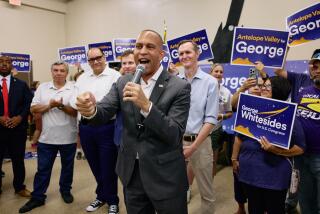June primary is key test for state’s top-two election system
- Share via
In the first broad test of California’s new “top-two” election system, many candidates in heated races for Congress and the state Legislature have been campaigning earlier, spending more money and downplaying their party affiliation as they try to widen their appeal.
Gone are the party primaries, except in the presidential race. Now all state candidates appear on a single ballot. Only those who come in first or second on June 5 will move on to the November general election, in which no write-in or other added candidates will be allowed.
The new rules, approved by California voters in 2010, further empower voters who don’t belong to a political party — already the fastest-growing category in California, accounting for more than 21% of the state’s registration.
For the first time, some ballots for 53 congressional, 20 state Senate and 80 Assembly seats include unaffiliated candidates. Among the 36 who list themselves with “no party preference” are two congressional candidates who recently ditched their party ties: Ventura County Supervisor Linda Parks and former Assemblyman Anthony Adams of Hesperia, both previously Republicans.
Along with the new voting districts drawn last year by a citizens commission rather than by lawmakers protecting their own seats, the fresh election rules have prompted many campaigns to rewrite their playbooks.
“What the open primary has done is reshuffle the strategic deck,” said Democratic strategist Richie Ross. “The timing and the manner in which you communicate have got to be adjusted.”
Going negative on opponents during the primary could come back to haunt a candidate if it alienates voters needed to win the November runoff, Ross said. Candidates are no longer assured of getting to November by courting only voters in their own party. And races in some districts that used to be all but over in the primary will probably remain competitive through the fall.
“It’s very complicated, very new, and everybody’s going to learn a lot about how this is going to work,” said Richard Temple, a GOP consultant. His clients this year include Nathan Mintz, one of two Republicans and a Democrat running for a “swing” Assembly seat in the South Bay’s 66th District that could be won by either major party in the fall.
The other Republican in the race is businessman Craig Huey, who already has sent out at least one mail advertisement introducing himself to voters and knocking the Democrat, Al Muratsuchi, a Torrance school board member and deputy state attorney general. Given the nearly even registration of the two parties in the district, local politics watchers view Muratsuchi as the probable winner of one runoff spot. Mintz and Huey have to compete for GOP voters while also wooing independents and third-party voters.
Those voters can be unpredictable. Moreover, unless there is a contested presidential race or a controversial ballot measure or two to stir their interest, most unaffiliated voters typically do not turn out in big numbers for primary elections. Temple and others think that will change dramatically once independents understand their new power, but it could take at least one or two election cycles to sink in.
Democratic consultant Mike Shimpock, who is overseeing Muratsuchi’s bid and that of several others, said the new rules present a new challenge in deciding when and where to spend campaign money. That is especially true in districts that are strongly Democratic — like many in the Los Angeles area — or heavily Republican.
Previously, a candidate who matched a district’s lopsided registration had only to worry about winning the party primary and would campaign hardest, and spend the most, for that purpose before coasting to victory in the runoff. Now, with the possibility that two members of the dominant party could square off in November, those strategic choices are trickier, Shimpock said.
Allan Hoffenblum, publisher of the California Target Book, which tracks elections, calculates that as many as eight congressional, four state Senate and 23 Assembly races could feature two members of the same party in the fall.
One could be an Assembly contest on Los Angeles’ largely affluent Westside. In the 50th district, Democrats hold a 52% to 19% registration advantage over Republicans, while nearly 24% of voters are unaffiliated.
Longtime community activist and nonprofit executive Torie Osborn, Assemblywoman Betsy Butler and Santa Monica Mayor Richard Bloom are the Democratic contenders; environmental attorney BradlyS. Torgan is the only Republican on the ballot. Osborn and Butler have raised more than $600,000 apiece, and most observers expect them to face each other in the fall. Bloom has raised $260,570 and Torgan, $425.
Osborn has sent out 10 political mail ads, starting in mid-April. Butler so far has sent three. All but one of Osborn’s mailers omit any reference to her party, although it can easily be discerned through the achievements and endorsements she lists.
John Shallman, her consultant, said he felt it was important to introduce Osborn, a first-time candidate, to voters early. “We wanted to be sure that voters knew about her, her life and her causes.”
“She’s proud to be a Democrat,” Shallman said, “but realizes people can get stuck in their [party] labels and don’t get things done. She’s been successful her whole life working across party lines.”
Ross, who is Butler’s consultant, said he and the assemblywoman have “plenty of gasoline left in our tank” for the remaining three weeks of the campaign. He added that voters in primaries usually don’t pay attention until then.
More to Read
Sign up for Essential California
The most important California stories and recommendations in your inbox every morning.
You may occasionally receive promotional content from the Los Angeles Times.











